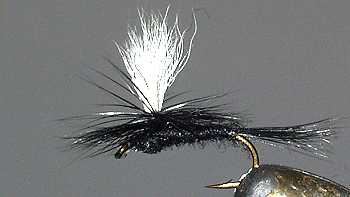The Black Gnat Parachute Dry Fly
Anglers use the term Black Gnat to describe a number of flat winged flies, but the Common Gnat belongs to the Culcidae insect group. It is strange to note that this fly's body is not black at all.

PARACHUTE EMERGER DRY FLIES. Hook size 12 14 16 18 20 24 - $US each
The female has a dark olive brown body. The male is darker still and as near black as to make no difference. These flies fall or get blown on to the water and trout are very partial to them. The Black Gnat is a pattern worth trying near the reedy margins of lakes. Gnats are prolific from late Spring till the end of the trout fishing season. They are bred on the land but spend the best part of their lives in the vicinity of ponds, streams and lakes. They may be seen in dense clouds over the water and fish will be rising madly to take their fill. At times like this a gnat pattern fished dry or wet will bring results. There are numerous dressings of the original black gnat pattern. Look for our black gnat dry fly and wet fly versions. This black parachute flies are ideal for BLACK STONEFLY imitations. They hatch in winter. Like all stoneflies they hatch on dry land but return to the water to lay eggs. Trout eagerly suck them down as soon as they land.
The term parachute fly is given to flies in which the hackle is tied round a projection affixed to the top of the hook shank near the eye so that the hackle lies horizontally across the hook which it covers in the manner of an open umbrella. The weight of the hook underneath the circular hackle balances the fly which falls lightly on the water parachute fashion. Various patterns are tied in the parachute style and a Scottish tackle firm was the first to commercially market these flies a long time ago. It is not certain who invented them but an American called William Brush of Detroit applied for an American patent for the idea in 1931 and it was granted in 1934. The patent related to the projection on the hook and not the fly itself.
The traditional way of dressing dry flies with upright wings and hackles that make the fly stand high on the water's surface may be very pleasing but it is not necessarily the best design for catching fish in some anglers opinions. The parachute dry fly style of dressing allows the fly to sit well down in or on the surface film, mimicking either an emerging mayfly dun filling its wings, a spent spinner, stillborn, floating nymph or a crippled drowning fly trapped in the surface film. They can be dramatically more effective at getting takes. Some traditionalist will not use them but I find them very effective and easy to cast correctly. I have found them more suited to still water fishing as once a ripple or two has broken over them they become waterlogged. The softer landing, the delicate presentation is one of this patterns principle benefits. The parachute effect of the hackle slows down the descent. It does not spook the fish as much as a normal dry fly. They are one of my favorite lake flies. When the trout are rising and taking food with a gentle sipping action these are the flies to use.
When the mayflies have stopped emerging and the surface action has died down. The fishing is not over if you know where to look. Go for a walk down the riverbank and look for bankside eddies, areas of slow slack pockets of water near faster moving water. A lot of mayflies do not successfully emerge during the hatch. They are referred to as cripples or stillborn. Others are flipped over, capsized in choppy water. They seem to collect in these eddies. You will find trout rising to them long after the original hatch has finished. Cast a Parachute into these pockets and let it drift. It is a great way to extend your surface fishing time.
Fly Fishing books

